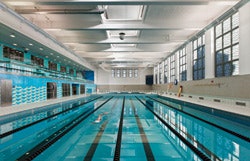As aging high school pools fall into disrepair, cash-strapped districts either are partnering with other entities to keep facilities afloat or deciding to shut them down.
 Photo of a lap pool
Photo of a lap pool
Within the span of only a few months last year, residents of the neighboring Northern California cities of Arcata and Eureka lost three of the communities' four public-access swimming pools. First, a massive leak that was draining 12,000 gallons of water a day shut down the 36-year-old pool at Eureka's College of the Redwoods; its future remains in question. Then came word that Arcata's Humboldt State University natatorium, scheduled to be replaced as part of a new $45 million physical education building, needed to close earlier than expected.
But the clincher occurred in December, when the heater failed in the half-century-old Eureka High School pool, which, it turns out, had drains that were not in compliance with the Virginia Graeme Baker Pool and Spa Safety Act. Facing declining enrollment and a severe budget crisis, district administrators opted to permanently drain the pool rather than pay for repairs.
That left only the six-lane, 25-yard Arcata Community Pool to satisfy the aquatic needs of an estimated 43,000 residents in the two communities, displacing Eureka High's swim team and forcing the USA Swimming-affiliated Humboldt Swim Club to temporarily cap its membership. HSU's new natatorium opened last summer and has eased some - but not all - of the strain on Arcata's pool.
Meanwhile, swimmer safety concerns have escalated. Numerous rivers, lakes, lagoons and creeks flow freely throughout Arcata and Eureka, and the Pacific Ocean looms large along the coastline. "I'm afraid we're going to have kids drown because they don't know how to swim, and we don't have anywhere to teach them," says Brian Nunn, co-chair of Mission: SwimPossible, a nonprofit organization originally formed to help the Eureka High pool stay financially afloat and now hoping to raise enough public and private funds to open an aquatic wellness center in the heart of Eureka. "We're surrounded by water. That's the harsh reality around here. I have a friend whose daughter drowned in a river."
A recent spate of high school pool closings - necessitated by shrinking budgets and reduced state funding that already have led to teacher layoffs, program eliminations and other academic and athletic cuts - is forcing local boards of education, swim organizations, recreation agencies and nonprofit groups to rethink the decades-old concept of the school pool. "Schools aren't set up to run pools," Nunn says. "Their plates are so full right now that the last thing they want to do is spend money on a pool."
The dichotomy is that swimming is enjoying unprecedented success in the wake of the 2008 Summer Olympics, where American swimmers took home 31 medals in the sport. Shortly after Michael Phelps broke Mark Spitz's record for the most gold medals in a single Olympiad, the National Federation of State High School Associations reported that swimming and diving gained the third-most new participants in 2007-08, trailing only lacrosse and soccer. And a post-Phelps surge likely will buoy the 2008-09 participation numbers even more. "That tells me we're not losing pools yet," says Becky Oakes, the federation's assistant director who oversees swimming.
 Photo of the renovated pool area at the Cambridge (Mass.) War Memorial Recreation Center
Photo of the renovated pool area at the Cambridge (Mass.) War Memorial Recreation CenterBut try explaining that to the 70-some residents of University City, Mo., who showed up at the high school natatorium for a school board meeting in May to protest the proposed closing of the pool. In need of more than $1.5 million in repairs - including a new humidification control system, rust removal, a new drain cover, and locker room and bleacher upgrades - the facility has been eating up more than $115,000 in annual operating expenses.
"It's an issue beyond the district," George Lenard, president of the USA Swimming-affiliated University City Swim Club, told the St. Louis Post-Dispatch, suggesting that the district seek funding from the city or private sources. Superintendent Joylynn Wilson has gone on record stating that collaboration with surrounding municipalities is one option for keeping the pool open.
Similarly, a pair of joint ventures might save the Norwalk (Conn.) High School pool - the city's only public swimming facility, which annually costs more than $200,000 for the district to run and hosts physical education classes and two co-op swim teams. Plans appeared to be falling into place this summer for a deal with the local utility company that would cut costs, and an agreement with the city might lead to the parks and recreation department handling pool rentals and assuming partial operational costs.
What's happening in University City and Norwalk could be the future of high school swimming pools, which have been an integral element of many education buildings constructed in the immediate aftermath of World War II - back when electricity was cheap, high-end liability insurance didn't exist and creative programming wasn't required.
"The paradigm is shifting," says Mick Nelson, facilities development director for USA Swimming, who estimates that 80 percent of the 300 to 400 pools that close every year are operated either by school districts or municipalities. "I don't think communities can sit any longer with a pool owned and run by a high school that only uses it for PE classes and swim team practices, and then expect the high school to keep supporting that pool. It is a drain on resources. Times have changed. Now some schools have hit a wall and are saying, 'We don't want to be in the pool business anymore.'"
"Schools have a hard time keeping up with maintenance in regular buildings, let alone buildings that have highly specialized operational systems like pools," adds George Metzger, president of HMFH Architects in Cambridge, Mass., whose firm recently oversaw a high school/municipal pool renovation at the Cambridge War Memorial Recreation Center, connected to the Cambridge Rindge and Latin School. "Running a pool is a very specialized operation."
 Photo of the pool renovation at the Cambridge (Mass.) War Memorial Recreation Center
Photo of the pool renovation at the Cambridge (Mass.) War Memorial Recreation CenterThe $26 million renovation of the three-story, 152,000-square-foot War Memorial facility, which doubles as home to the high school's sports teams and is owned by the school district but managed by the city, included gutting the natatorium and restoring the three pools that had "suffered benign abuse," Metzger says. "Their ability to be used was limited. The systems were a constant headache, and the HVAC and lighting were pretty outmoded."
The renovated six-lane, 25-yard pool, along with a children's pool and a diving well, opened in January with spectator seating for 275. The natatorium provides multiple activities throughout the day for a broad range of users that include everyone from students to families with small children to professors from nearby Harvard University. The majority of costs were covered by state funds and city bonds, not the school district.
"High schools are still building pools, but right now they're a little more diligent about preplanning, rather than just going out there, building a six-lane pool and saying, 'Now, what do we do with it?,'" Nelson says. "I think they're starting to get the idea that programming precedes design. Sooner or later, someone is going to have to program these pools, so that during the day they have more community impact and generate enough of an income to be self-sustaining."
That's the message USA Swimming has been sending for the past five years, as it encourages some of its 2,700 swim teams around the country to enter management partnerships with local high schools in an effort to increase revenue streams. In the most common type of arrangement, a pool could still be used for physical education classes and interscholastic and club team practices, but the club also would provide additional community programming - pre-school learn-to swim classes and adult programming, for example - during daytime hours when the pool had previously been dormant. Then, when maintenance issues arise, a capital maintenance fund would already be in place with the revenues generated by the partnership.
"What happens when your scoreboard rusts out? What happens when your blocks need replacing? Money for that needs to be in the bank," Nelson says, suggesting that schools designate the annual salary of one mid-level employee as the amount that goes into a capital maintenance, repairs and improvements fund every year. "You actually have to create the income. So in one year, you would make several thousand dollars that would allow you to replace the blocks, replace a heater and maybe get a medium-pressure UV system. You'd be in a heck of a better position than you were in 12 months ago."
While a local swim club won't always be able to rescue the school pool, district administrators need to know that assistance might be available - if not from clubs, then possibly from other public and private entities. "There must be some creative thinking," Oakes says. "You may see some additional joint ventures that may not have happened a few years ago."
 Photo of the Olympic-size pool at North Central High School in Indianapolis
Photo of the Olympic-size pool at North Central High School in IndianapolisThe good news is that the closing of high school pools has not reached "epidemic" proportions, Oakes and Nelson say. For one happy ending, look to Martin County High School in Stuart, Fla., where a joint venture between the county commission and the school board is keeping the aging pool open for another year until it can be replaced by a $9 million county-owned aquatics complex across the street. Rather than prematurely shut down the existing pool - used by hundreds of prep, club and adult swimmers - the two entities reached an agreement in June to each pay $113,000 to keep the pool open. If $226,000 turns out not to be enough, county parks director Richard Blankenship has suggested reducing the facility's hours of operation.
In Maryland's Frederick County, a joint venture wasn't even necessary. School board members simply acknowledged the wishes of several swimmers and other community members by rejecting a money-saving proposal to eliminate varsity swimming and close the county's three high school pools. Instead, they decided to consider more than two dozen other cost-saving measures, including slashing overtime, reducing staff workshop expenses and setting all building thermostats to the same temperature.
And at North Central High School in Indianapolis, a brand-new $13.8 million natatorium opened in April. Originally part of a $90 million construction and renovation bond issue that was subsequently reduced to $50 million after public outcry, the sixth Olympic-size pool built at an Indiana high school during the past five years replaced a deteriorating 36-year-old facility that lacked lane space and threatened swimmers' health due to its poor ventilation. Plans call for the school's old pool to be filled in and converted to a fitness center. "They've built a very nice pool that made sense for the needs of the school and the community," Don Barr, a member of a citizens group that forced the bond to be lowered, told The Indianapolis Star. "The old one needed a heck of a lot of repair work and needed to be replaced. The new pool is going to get a lot of use."
Mission: SwimPossible's Nunn knows that a new aquatic facility in Eureka would get a lot of use, too. That's why the former director of marketing for an area hospital has devoted the past year to the nonprofit organization intent on getting one built. Originally, though, he just wanted to save Eureka High's pool. When school officials announced their intentions in mid-2008 to close the facility for budgetary reasons, Nunn (whose children swim competitively) rounded up several other swimming supporters and took on the school board. "We went to a meeting and told them, 'You can't close the pool. There have to be other options, so let's look at them.'"
Told that the cost of keeping the pool open totaled $4,500 a month, Nunn returned to the school board three weeks later with a business plan that contained a schedule of pool events (including swim meets and adult education classes) that would generate $19,000 for the school - enough to keep the pool in the black for more than four months. Then he went out and scheduled more activities to help the pool survive the 2008-09 school year. When he couldn't book enough events to make ends meet, he made up the difference with donated cash and checks from local residents who shared with him stories of how they and their children (and their children's children) learned to swim in the school's pool. "We showed up at the school board meeting each month with my daughter's swim cap and her goggles wrapped around it, with a bunch of money inside," Nunn says. "But I knew that as soon as something mechanical went, we would be done. It's sort of like an old car that has 160,000 miles on it. Do you keep pouring money into it, or do you just stop?"
That answer arrived less than midway through the school year, in the form of the busted heater and new federal regulations. So Mission: SwimPossible set out to generate support for a privately operated 30,000-square-foot aquatic center that likely will have three pools designated for training and competition, teaching and rehabilitation. Funding for the facility, estimated to cost between $5.3 million and $6.5 million and slated to open by summer 2011, is expected to come from the cities of Eureka and Arcata, as well as grants and other sources. "You've got to mix your nonprofits with your for-profits," Nunn says. "The reason the cities are so positive is because we didn't just go in and say we need a pool. We spent three or four months developing a business plan to show that we could sustain it once it's built, and then we went to the cities and said, 'Do you want to help us?'"
With annual operating expenses anticipated to top $630,000, the new facility has the potential to bring in almost $840,000 per year, Nunn says, and it will pave the way for Mission: SwimPossible's next goal: an Olympic-size pool that likely would attract swimmers from all over northern California and southern Oregon. "What's been fun about this project is that there's no downside. It's not a Democrat/Republican issue. It's not a cultural issue. Everybody sees the value of having pools for the community. It's just a matter of where the money's going to come from."




































